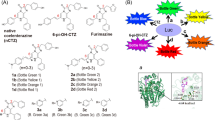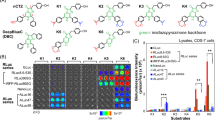Abstract
Bioluminescence (BL) is broadly used as an optical readout in bioassays and molecular imaging. In this study, the near-infrared (NIR) BL imaging systems were developed. The system was harnessed by prototype copepod luciferases, artificial luciferase 30 (ALuc30) and its miniaturized version picALuc, and were characterized with 17 kinds of coelenterazine (CTZ) analogues carrying bulky functional groups or cyanine 5 (Cy5). They were analyzed of BL spectral peaks and enzymatic kinetics, and explained with computational modeling. The results showed that (1) the picALuc-based system surprisingly boosts the BL intensities predominantly in the red and NIR region with its specific CTZ analogues; (2) both ALuc30- and picALuc-based systems develop unique through-bond energy transfer (TBET)-driven spectral bands in the NIR region with a Cy5-conjugated CTZ analogue (Cy5-CTZ); and (3) according to the computational modeling, the miniaturized version, picALuc, has a large binding pocket, which can accommodate CTZ analogues containing bulky functional groups and thus allowing NIR BL. This study is an important addition to the BL imaging toolbox with respect to the development of orthogonal NIR reporter systems applicable to physiological samples, together with the understanding of the BL-emitting chemistry of marine luciferases.
Graphical abstract






Similar content being viewed by others
Data availability
The data presented in this study are available on request from the corresponding author.
References
Shimomura, O. (2006). Bioluminescence. World Scientific Publishing Co. Pte. Ltd.
Ozawa, T., Yoshimura, H., & Kim, S. B. (2013). Advances in fluorescence and bioluminescence imaging. Analytical Chemistry, 85(2), 590–609.
Kim, S. B., & Paulmurugan, R. (2021). Bioluminescent imaging systems for assay developments. Analytical Sciences, 37(2), 233–247.
Iwano, S., Sugiyama, M., Hama, H., Watakabe, A., Hasegawa, N., Kuchimaru, T., Tanaka, K. Z., Takahashi, M., Ishida, Y., Hata, J., Shimozono, S., Namiki, K., Fukano, T., Kiyama, M., Okano, H., Kizaka-Kondoh, S., McHugh, T. J., Yamamori, T., Hioki, H., … Miyawaki, A. (2018). Single-cell bioluminescence imaging of deep tissue in freely moving animals. Science, 359(6378), 935–939.
Loening, A. M., Wu, A. M., & Gambhir, S. S. (2007). Red-shifted Renilla reniformis luciferase variants for imaging in living subjects. Nature Methods, 4(8), 641–643.
Iwano, S., Obata, R., Miura, C., Kiyama, M., Hama, K., Nakamura, M., Amano, Y., Kojima, S., Hirano, T., Maki, S., & Niwa, H. (2013). Development of simple firefly luciferin analogs emitting blue, green, red, and near-infrared biological window light. Tetrahedron, 69(19), 3847–3856.
Tamaki, S., Kitada, N., Kiyama, M., Fujii, R., Hirano, T., Kim, S. B., & Maki, S. (2021). Color-tunable bioluminescence imaging portfolio for cell imaging. Scientific Reports, 11(1), 2219.
Hastings, J. W. (1996). Chemistries and colors of bioluminescent reactions: a review. Gene, 173(1), 5–11.
Viviani, V. R., Uchida, A., Viviani, W., & Ohmiya, Y. (2002). The influence of Ala243 (Gly247), Arg215 and Thr226 (Asn230) on the bioluminescence spectra and pH-sensitivity of railroad worm, click beetle and firefly luciferases. Photochemistry and Photobiology, 76(5), 538–544.
Hall, M. P., Unch, J., Binkowski, B. F., Valley, M. P., Butler, B. L., Wood, M. G., Otto, P., Zimmerman, K., Vidugiris, G., Machleidt, T., Robers, M. B., Benink, H. A., Eggers, C. T., Slater, M. R., Meisenheimer, P. L., Klaubert, D. H., Fan, F., Encell, L. P., & Wood, K. V. (2012). Engineered luciferase reporter from a deep sea shrimp utilizing a novel imidazopyrazinone substrate. ACS Chemical Biology, 7(11), 1848–1857.
Dijkema, F. M., Nordentoft, M. K., Didriksen, A. K., Corneliussen, A. S., Willemoes, M., & Winther, J. R. (2021). Flash properties of Gaussia luciferase are the result of covalent inhibition after a limited number of cycles. Protein Science, 30(3), 638–649.
Ohmuro-Matsuyama, Y., Furuta, T., Matsui, H., Kanai, M., & Ueda, H. (2022). Miniaturization of bright light-emitting luciferase ALuc: picALuc. ACS Chemical Biology, 17(4), 864–872.
Auld, D. S., Narahari, J., Ho, P. I., Casalena, D., Nguyen, V., Cirbaite, E., Hughes, D., Daly, J., & Webb, B. (2018). Characterization and use of TurboLuc luciferase as a reporter for high-throughput assays. Biochemistry, 57(31), 4700–4706.
Inouye, S., & Sahara, Y. (2008). Identification of two catalytic domains in a luciferase secreted by the copepod Gaussia princeps. Biochemical and Biophysical Research Communications, 365(1), 96–101.
Takenaka, Y., Masuda, H., Yamaguchi, A., Nishikawa, S., Shigeri, Y., Yoshida, Y., & Mizuno, H. (2008). Two forms of secreted and thermostable luciferases from the marine copepod crustacean, Metridia pacifica. Gene, 425(1–2), 28–35.
Takenaka, Y., Yamaguchi, A., Tsuruoka, N., Torimura, M., Gojobori, T., & Shigeri, Y. (2012). Evolution of bioluminescence in marine planktonic copepods. Molecular Biology and Evolution, 29(6), 1669–1681.
Kim, S. B., Torimura, M., & Tao, H. (2013). Creation of artificial luciferases for bioassays. Bioconjugate Chemistry, 24(12), 2067–2075.
Takenaka, Y., Noda-Ogura, A., Imanishi, T., Yamaguchi, A., Gojobori, T., & Shigeri, Y. (2013). Computational analysis and functional expression of ancestral copepod luciferase. Gene, 528(2), 201–205.
Heffern, M. C. (2017). Diversifying the glowing bioluminescent toolbox. ACS Central Science, 3(12), 1234–1236.
Nishihara, R., Paulmurugan, R., Nakajima, T., Yamamoto, E., Natarajan, A., Afjei, R., Hiruta, Y., Iwasawa, N., Nishiyama, S., Citterio, D., Sato, M., Kim, S. B., & Suzuki, K. (2019). Highly bright and stable NIR-BRET with blue-shifted coelenterazine derivatives for deep-tissue imaging of molecular events in vivo. Theranostics, 9(9), 2646–2661.
Shimomura, O. (1995). Cause of spectral variation in the luminescence of semisynthetic aequorins. Biochemical Journal, 306, 537–543.
Yeh, H. W., Karmach, O., Ji, A., Carter, D., Martins-Green, M. M., & Ai, H. W. (2017). Red-shifted luciferase-luciferin pairs for enhanced bioluminescence imaging. Nature Methods, 14(10), 971–974.
Tannous, B. A. (2009). Gaussia luciferase reporter assay for monitoring biological processes in culture and in vivo. Nature Protocols, 4(4), 582–591.
Abe, M., Nishihara, R., Ikeda, Y., Nakajima, T., Sato, M., Iwasawa, N., Nishiyama, S., Paulmurugan, R., Citterio, D., Kim, S. B., & Suzuki, K. (2019). Near-infrared bioluminescence imaging with a through-bond energy transfer cassette. ChemBioChem, 20(15), 1919–1923.
Loening, A. M., Fenn, T. D., Wu, A. M., & Gambhir, S. S. (2006). Consensus guided mutagenesis of Renilla luciferase yields enhanced stability and light output. Protein Engineering, Design & Selection, 19(9), 391–400.
Wu, N., Kobayashi, N., Tsuda, K., Unzai, S., Saotome, T., Kuroda, Y., & Yamazaki, T. (2020). Solution structure of Gaussia luciferase with five disulfide bonds and identification of a putative coelenterazine binding cavity by heteronuclear NMR. Scientific Reports, 10(1), 20069.
Acknowledgements
This work was supported by grants from the Japan Society for the Promotion of Science (JSPS Grants 21H04948, 20K21851, and 17H01215).
Author information
Authors and Affiliations
Contributions
SBK mainly wrote the main manuscript, and SBK and TF prepared all the figures. All authors reviewed the manuscript.
Corresponding author
Ethics declarations
Conflict of interest
YOM is an employee of Shimadzu Corporation. SBK and TF received research funding from Shimadzu Corporation. The other authors have no competing interests to declare.
Supplementary Information
Below is the link to the electronic supplementary material.
43630_2023_367_MOESM1_ESM.docx
Supplementary file1 Figure S1. BL images of picALuc at various wavelengths; Figure S2. Determination of the BL intensities of picALuc according to the substrates, 2a, 2b, and 2c, in living mammalian cells (DOCX 3286 KB)
Rights and permissions
Springer Nature or its licensor (e.g. a society or other partner) holds exclusive rights to this article under a publishing agreement with the author(s) or other rightsholder(s); author self-archiving of the accepted manuscript version of this article is solely governed by the terms of such publishing agreement and applicable law.
About this article
Cite this article
Kim, SB., Furuta, T., Ohmuro-Matsuyama, Y. et al. Bioluminescent imaging systems boosting near-infrared signals in mammalian cells. Photochem Photobiol Sci 22, 1267–1278 (2023). https://doi.org/10.1007/s43630-023-00367-8
Received:
Accepted:
Published:
Issue Date:
DOI: https://doi.org/10.1007/s43630-023-00367-8




